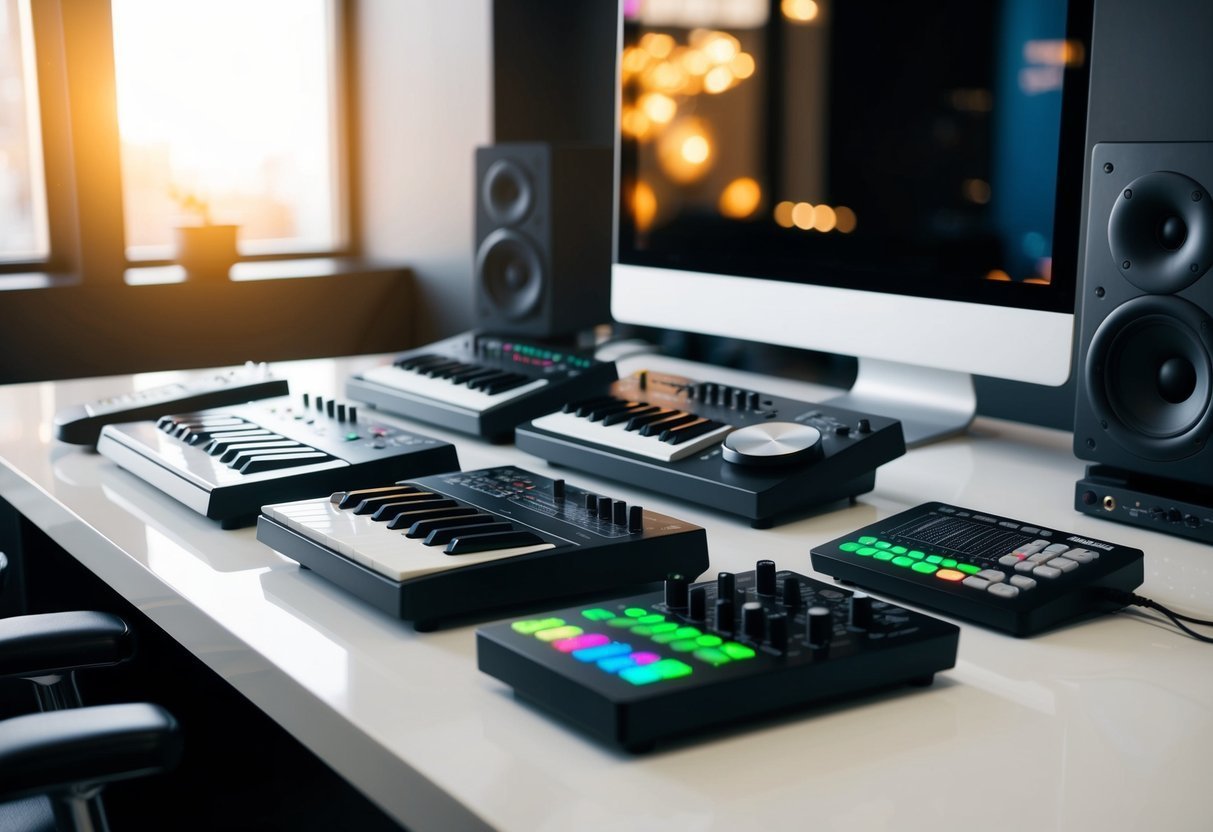When you dive into the world of music production, you’ll often hear the term MIDI controllers.
These handy devices play a crucial role for musicians and producers by bridging the digital and physical realms of music creation. A MIDI controller is a tool that lets you generate and transmit Musical Instrument Digital Interface (MIDI) data to control various instruments and software.
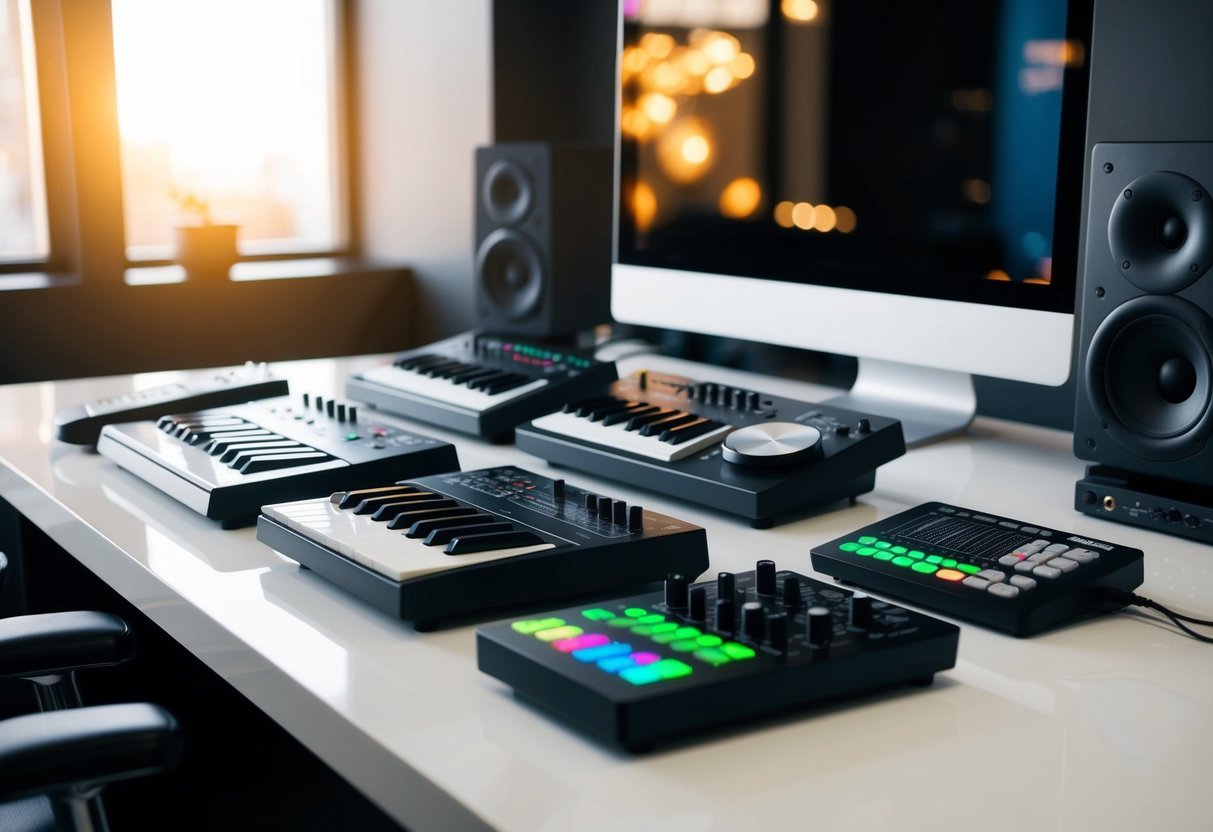
Think of a MIDI controller as your digital music toolkit.
With keys, pads, and knobs, you can tweak sound parameters, trigger notes, and bring your musical ideas to life within a Digital Audio Workstation (DAW).
The possibilities are vast, whether you’re looking to perform, produce, or design soundscapes.
With numerous options available from top brands like Akai, Yamaha, and Arturia, you can find a MIDI controller that perfectly fits your creative style.
Whether you prefer a compact controller for portability or something more robust for intricate performances, there’s a solution out there for you.
With the right choice, you’ll enhance your musical journey, making it easier and more enjoyable.
Understanding MIDI
MIDI is vital for connecting your music gear and software, allowing diverse devices to communicate through standardized signals.
This network supports activities from recording to live performing, all without wires or audio signals.
What Is MIDI?
MIDI, which stands for Musical Instrument Digital Interface, is a protocol that enables electronic musical instruments, computers, and other equipment to communicate.
This technology allows you to connect devices like keyboards, controllers, and computers to create, edit, and play music.
Instead of streaming actual audio, MIDI sends instructions such as note on/off and velocity.
This separation allows for versatile composition and editing possibilities without altering the original sound output of a device or software.
The Evolution of MIDI Signals
Launched in the early 1980s, MIDI revolutionized how electronic devices interacted.
Initially limited by a simple design, MIDI has evolved over the years to include more complex capabilities.
MIDI 1.0 provided the basic groundwork, supporting messages like note events and control changes.
Over time, enhancements were developed, such as MIDI 2.0.
This newer version addresses limitations like resolution and offers more functionalities for modern users.
As technology advances, the role of MIDI continues to expand, adapting to new devices and genres.
MIDI Information and Communication
MIDI transmits a variety of important information through signals.
In practice, these are messages that carry essential data.
Each MIDI message is encoded to perform specific tasks.
For example, a ‘note on’ message includes which note to play and how hard to play it.
Communication happens via a 5-pin DIN cable or USB, bridging digital instruments with audio software.
This flexibility greatly impacts how you produce music, granting you the ability to manipulate sounds, automate performances, and synchronize projects seamlessly across platforms.
Types of MIDI Controllers
MIDI controllers come in various forms, each offering unique features for different kinds of music production and performance needs.
Here, you’ll find a look at some of the most popular types, like MIDI keyboards and pad controllers, as well as niche options like wind and guitar controllers.
MIDI Keyboards
MIDI keyboards are probably what most people think of first when it comes to MIDI controllers.
They range from compact 25-key versions to full-sized 88-key models.
They offer a range of features, from simple note triggering to advanced controls like pitch bend and modulation wheels.
Whether you’re sketching out a song in a DAW or performing live, these keyboards offer tactile, piano-like input that’s versatile and expressive.
There are unweighted keys that resemble a synth action, ideal for fast playing and electronic music.
For a more authentic piano feel, you can go for weighted keys.
They’re highly compatible with both hardware synths and software instruments, giving you plenty of options depending on your setup and style.
Pad Controllers
Pad controllers are a staple in electronic music production, perfect for programming drum beats, triggering samples, or controlling virtual instruments.
They generally feature a grid of velocity-sensitive pads that allow dynamic expressions.
Popular models like the Akai MPC have made this type of controller nearly synonymous with beat-making.
Because they’re versatile, you can use pad controllers for live performances or studio work.
They often include features like note repeat and step sequencing, allowing you to produce complex rhythms effortlessly.
Whether tapping out drum patterns or launching clips in a live set, pad controllers offer a different flavor of hands-on control.
Wind Controllers
Wind controllers are designed for musicians who are comfortable with wind instruments like the saxophone or clarinet.
They can produce a wide array of sounds by converting your breath into MIDI data.
These controllers typically feature keys or touch-sensitive buttons designed to mimic traditional wind instruments.
They are useful for both live performances and studio sessions, allowing you to trigger a wide range of MIDI-compatible sounds just by blowing and fingering similar to an actual instrument.
This makes transitioning from acoustic wind instruments to digital music production more intuitive.
MIDI Guitar Controllers
Guitar controllers are aimed at guitarists looking to explore the world of MIDI.
They translate guitar string vibrations into MIDI signals, letting you control synthesizers and other MIDI-equipped hardware or software.
This means you can play a synth lead or a bassline using your guitar skills.
You can expect different levels of response and feature sets, from simple pitch-to-MIDI converters to more sophisticated models with a range of additional controls.
Whether you’re performing on stage or crafting new tracks in the studio, these controllers provide a perfect bridge for guitarists into the realm of digital music.
Features to Consider
When shopping for a MIDI controller, it’s crucial to pay attention to the key action types, additional knobs and faders, performance pads, and various input/output options.
These features will greatly influence how you interact with your music setup and the capabilities you have at your fingertips.
Key Action Types
The feel of the keys is crucial, so understanding the types of key actions available is important.
You might prefer weighted keys if you want a feel similar to an acoustic piano.
Weighted keys offer resistance, making it easier to control dynamics.
Velocity-sensitive keys are another key feature.
They respond to how hard or softly you press them, giving you a wider dynamic range and expression.
Some keyboards also offer semi-weighted or synth-action keys, which have a lighter touch and might suit those who prefer fast playability without resistance.
Knobs, Faders, and Switches
Extra controls like knobs and faders can really enhance your MIDI controller by offering tactile control over your sound.
They allow you to adjust volume, tweak filter cutoffs, and automate effects in real time.
Switches might be less talked about, but they’re a game changer for toggling settings or selecting modes quickly.
Many controllers offer programmable options, so you can customize them to match your performance needs.
Having these additional controls cuts down on the need to constantly use a mouse, creating a more seamless workflow.
Performance Pads
Performance pads are a favorite for many producers.
They’re generally used to trigger sounds, loops, or sequences and are usually velocity-sensitive, offering dynamic control over your beats.
Look for pads that come with an RGB color feature to visually organize your samples.
Some controllers even allow you to switch pad modes, giving you flexibility in how you use them during live and studio sessions.
The more responsive the pads are, the better your playing experience will be.
Additional Input/Output
MIDI controllers don’t just send information to your computer or synthesizer; they can also receive data. MIDI In and Out ports are essential if you want to integrate with other hardware devices, allowing you to control multiple instruments simultaneously.
Some controllers come with additional USB ports or even powered USB hubs to connect other gear.
An auxiliary pedal input for sustaining notes can also add a lot of value, especially for more expressive performance styles.
When checking the specs, ensure the controller meets your connectivity needs for a seamless setup.
Integrating with DAWs
When you’re hooking up a MIDI controller with a DAW, compatibility and smooth integration are key to maximizing your setup.
Ensuring your controller communicates effectively with your software can streamline your workflow and expand your creative possibilities.
DAW Compatibility
Not all DAWs are created equal, and each one has specific requirements and capabilities.
Start by checking if your MIDI controller is compatible with your chosen DAW.
Popular DAWs like Ableton Live, Logic Pro, and FL Studio offer wide support for many MIDI controllers.
Look for details on driver installation and connectivity options, such as USB, Thunderbolt, or Bluetooth.
Sometimes, you’ll need to download specific drivers from the controller manufacturer’s website to ensure optimal performance.
Compatibility isn’t just about physical connections.
Consider how well the controller’s features align with your DAW’s functions.
For instance, some controllers offer dedicated pads for triggering samples in Ableton Live, while others might have transport controls ideal for Pro Tools.
Knowing your controller’s strengths can help you choose a DAW that complements its capabilities.
Software Integration
Once you’ve confirmed compatibility, it’s time for software integration.
This begins with creating a MIDI map, allowing you to assign specific functions within the DAW to the controls on your MIDI controller.
This could involve mapping faders to track volumes or knobs to filter parameters.
Many DAWs let you save these configurations as templates for future projects.
Plug-ins are another critical component.
Your DAW should support plug-in formats such as VST, AU, or AAX if you plan to use virtual instruments or effects.
Check whether the MIDI controller offers any bundled software or plug-ins, which can broaden your creative toolkit.
With everything perfectly integrated, you’ll find that your workflow is smoother and your musical ideas can come to life with ease.
Popular MIDI Controllers
When diving into the world of MIDI controllers, you’ll find a vast array of options that cater to both beginners and professional musicians.
Some controllers are designed for ease of use, while others provide advanced features for seasoned producers.
For Beginners
If you’re just starting, finding a user-friendly MIDI controller is key. Akai Professional MPK Mini MK3 is a great choice with its compact design and portability.
It offers velocity-sensitive pads and assigning knobs that help you experiment with different sounds easily.
The Novation Launchkey Mini Mk3 stands out with its seamless integration with DAWs, especially Ableton Live.
Its intuitive layout makes it perfect for learning the ropes without overwhelming you with too many options.
Focusing on reliability, these controllers ensure you have a simple yet powerful tool to start your music production journey.
Their features are enough to explore your creativity without breaking the bank.
For Pros
For those more advanced in their craft, controllers like the Arturia KeyLab 88 MkII offer a premium experience.
With weighted keys and robust build quality, it suits professional settings and provides control over intricate music compositions.
If electronic music production is your field, invest in the Novation Launchpad Pro MK3.
Its grid of RGB pads allows detailed control over live performances and studio production, giving you flexibility.
These controllers provide precision and depth that professionals need for complex projects.
You’ll find that they enhance both studio work and live performances with their advanced capabilities.
Choosing Your First Controller
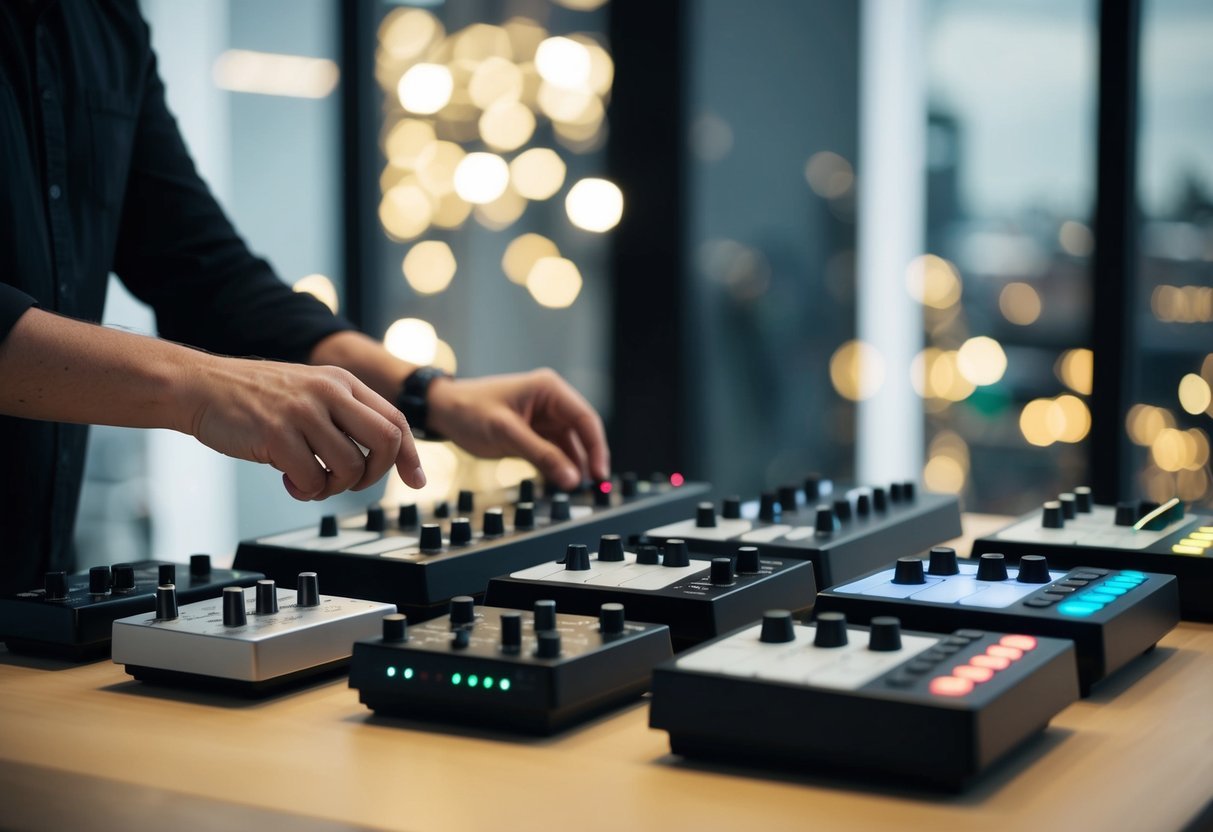
When picking your first MIDI controller, consider your music production style. MIDI controllers come in various sizes, typically featuring 25, 37, 49, 61, or 88 keys.
A 25-key option might be perfect for portability and simple tasks like triggering samples.
Think about the number of controls you need.
Many controllers offer additional features like drum pads, faders, and knobs.
These can significantly enhance your interaction with MIDI devices and software.
Make sure your controller is compatible with your DAW (Digital Audio Workstation).
This usually involves connecting via USB and configuring MIDI settings in your DAW’s preferences.
If you’re considering the best MIDI controller for beginners, look for something user-friendly yet versatile enough to grow with your skills.
Models like the M-Audio Axiom are popular due to their robust build and useful features.
Price is another important factor.
You don’t need to splurge on the latest model.
Many affordable options provide great functionality without breaking the bank.
Setting Up Your MIDI Controller
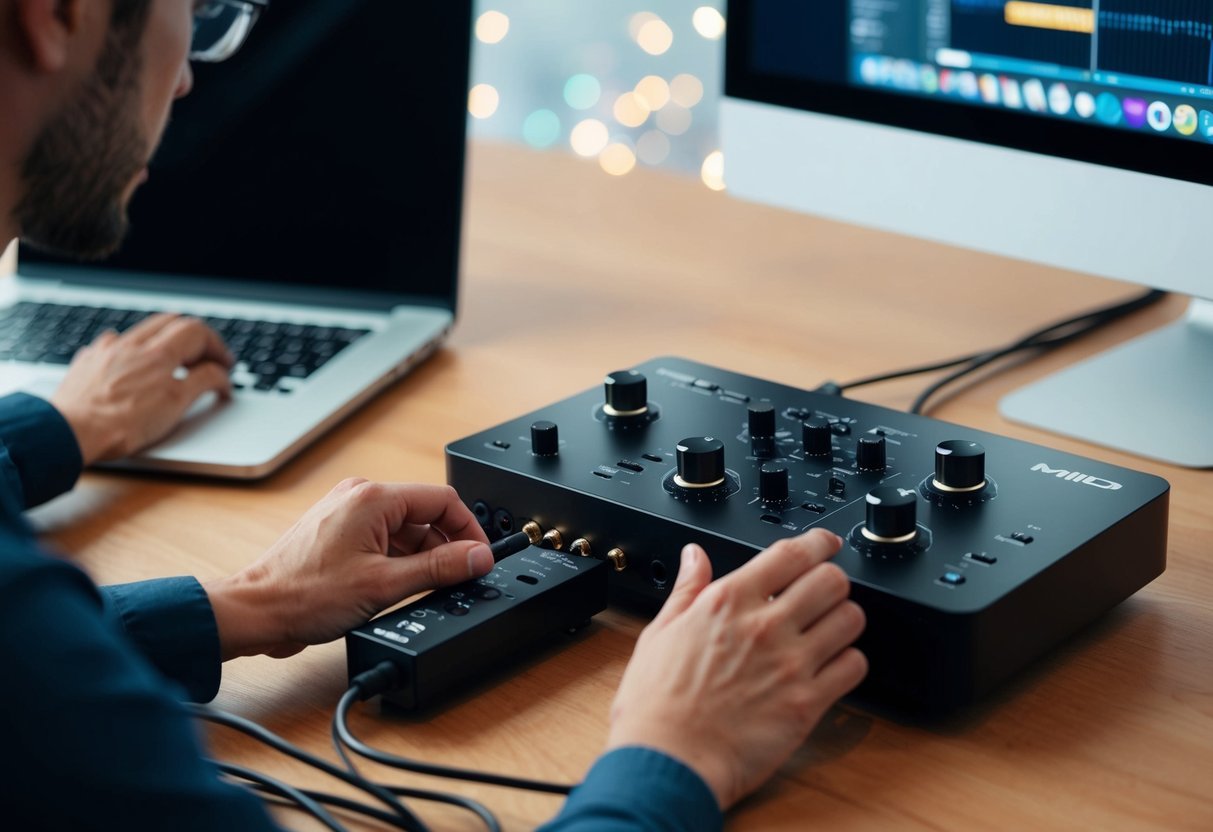
Getting your MIDI controller up and running involves connecting it to your computer and mapping its controls.
This process allows you to start creating music efficiently and effectively with your setup.
Connecting to a Computer
To connect your USB MIDI controller to your computer, ensure you have a suitable USB cable.
Most modern controllers are plug-and-play, which means you normally don’t need additional drivers.
Just plug it in, and your operating system should recognize it.
For older or specific MIDI controllers, you might require drivers from the manufacturer’s website.
Audio Interfaces can be involved if you need better audio quality when using your MIDI controller.
Plug your MIDI device into the interface if it supports MIDI connections, then link the interface to your computer.
This setup can provide enhanced sound management options and reduced latency.
Make sure your controller is powered on and properly connected.
Check your computer’s device manager or system preferences to confirm that the controller is recognized.
Troubleshoot the connection if the device doesn’t appear or respond.
Mapping Controls
Mapping controls are crucial for customizing how your MIDI controller interacts with your music software.
Start by opening your digital audio workstation (DAW) and accessing the MIDI settings or preferences.
Select your controller from the input options to make sure it’s activated.
In many DAWs, you can assign specific knobs, faders, or pads on your controller to various software functions.
This mapping allows you to control effects, instruments, and tracks seamlessly.
Look for the MIDI learn feature, which simplifies the mapping by letting you select a parameter and then moving a hardware control to assign it.
Consider creating different maps tailored to different projects or workflows for greater efficiency.
If available, utilize control surfaces and scripts to automate and enhance your setup further.
Advanced MIDI Techniques
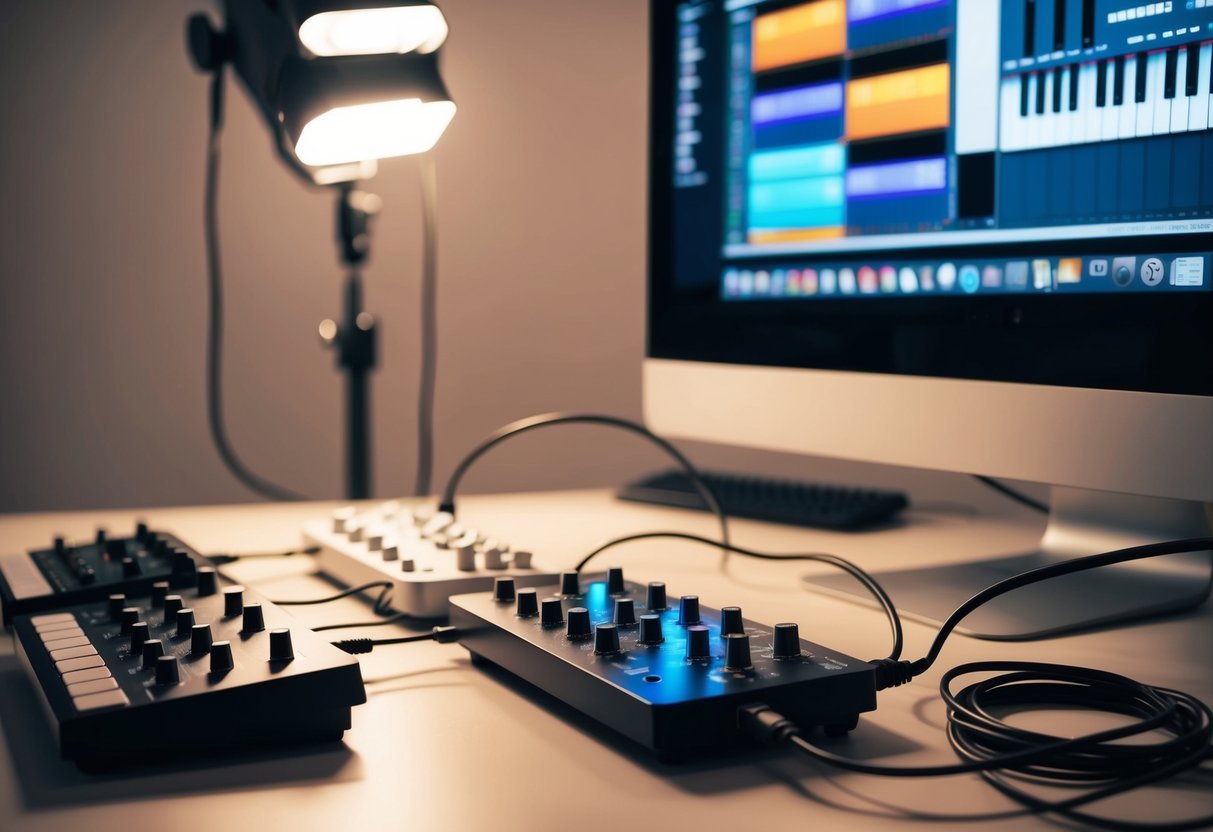
Exploring advanced MIDI techniques can elevate your music production game.
By mastering sequencing, looping, and sound design, you unlock powerful tools that enhance creativity and performance.
Sequencing and Looping
Get the most out of MIDI Sequencers by diving into sequencing and looping.
These features let you create dynamic patterns and loops, making your tracks more engaging.
A built-in sequencer allows you to arrange sequences and loops without needing extra gear.
You can adjust parameters like note length, velocity, and tempo to shape your music precisely.
Looping is perfect for live performance, enabling you to layer sounds and build complex arrangements on the fly.
Experiment with different start and stop points or change the loop length to add variety to your music.
Sound Design with Virtual Instruments
Using MIDI controllers for sound design opens up endless possibilities.
With virtual instruments, you can craft unique sounds by manipulating parameters such as waveforms, filters, and effects.
Connect your MIDI controller to virtual synths or software plugins.
Adjust controls like pitch, modulation, and resonance to customize your sound palette.
Many virtual instruments have presets you can tweak, helping you understand how different parameters affect the overall sound.
These features make it easy to experiment and find the perfect sound for your project, pushing the boundaries of your creativity.
Exploring MIDI Controllers by Brand
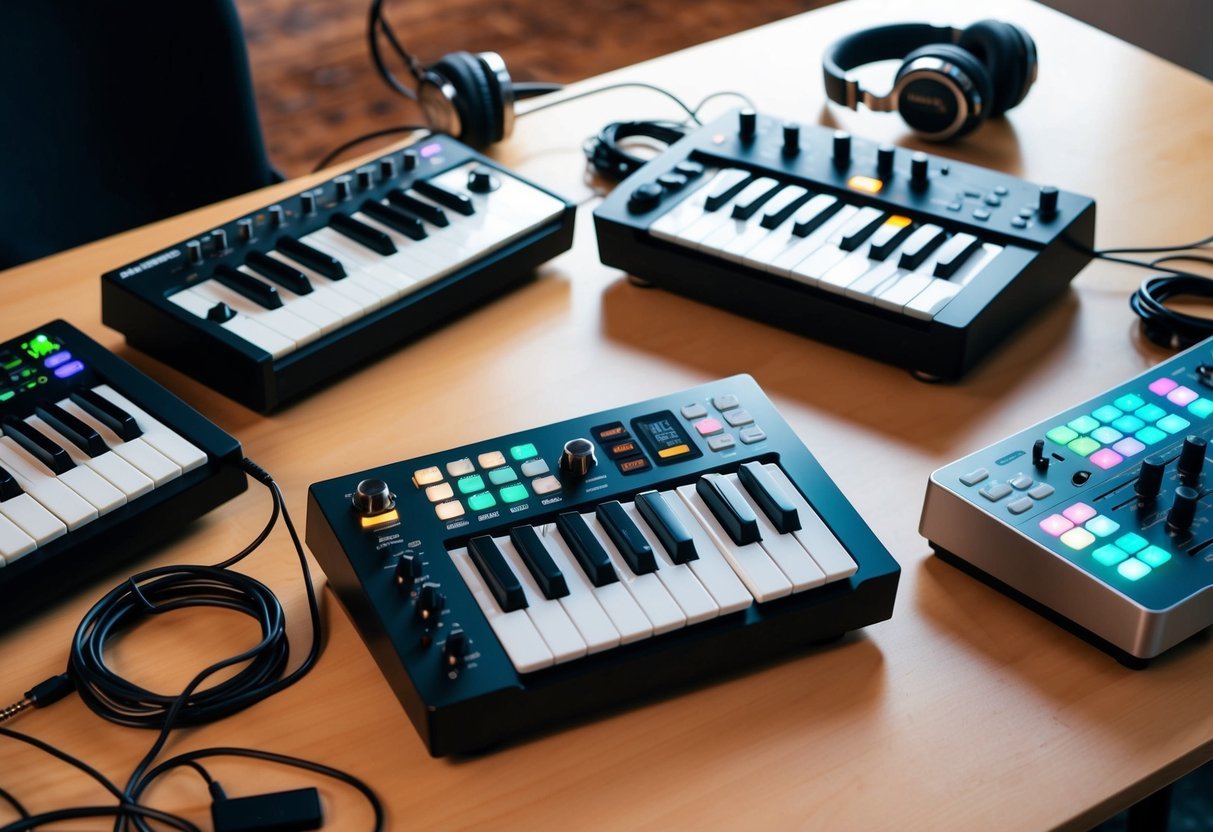
MIDI controllers come in a variety of shapes and sizes, offering diverse features across different brands.
This section explores some notable lines, focusing on Novation, Akai, and Arturia.
Each brand brings something special to the table, making it easier for you to find the right fit for your music production needs.
Novation’s Launchkey Series
Novation is a well-respected brand in the MIDI controller world, particularly known for the Launchkey series.
These controllers are perfect if you’re using Ableton Live, with intuitive integration and functionality tailored to the software.
You’ll find features like RGB pads, which let you control clips, preview changes, and more with ease.
The FLKey versions are specifically optimized for FL Studio users, making production a breeze.
With the smooth feel of the keys and compatibility with multiple software, they offer a versatile experience.
Whether you’re a beginner or a seasoned musician, the seamless connectivity with your DAW will certainly enhance your workflow.
Akai’s Professional Lineup
Akai’s lineup is synonymous with professional-grade MIDI controllers.
The MPK Mini MKIII is a top choice for music creators on the go, offering a compact build without sacrificing functionality.
You get 8 backlit pads and an arpeggiator, making it perfect for beat-making and melodic ideas.
The larger models in the lineup, like the MPK261, provide more extensive controls and an array of features, including faders and extra controls for those who need more from their setup.
Akai’s strong reputation is backed by its focus on durability and performance, ensuring you get the best quality for both studio and live settings.
Arturia’s Key Controllers
Arturia cables you into the world of music creation with controllers like their MiniLab 3, which are ideal for musicians who require portability without giving up features.
With 25 slim keys, 8 RGB pads, and 8 rotary encoders, you’re equipped to control various software instruments seamlessly.
Known for their exceptional integration with Analog Lab software, these controllers offer hands-on manipulation of vintage sounds.
Arturia’s devotion to crafting tactile and user-friendly tools makes them a favorite among synth enthusiasts.
If you’re searching for a combination of style, portability, and depth, Arturia’s approach delivers all that and more.
MIDI in Electronic Music
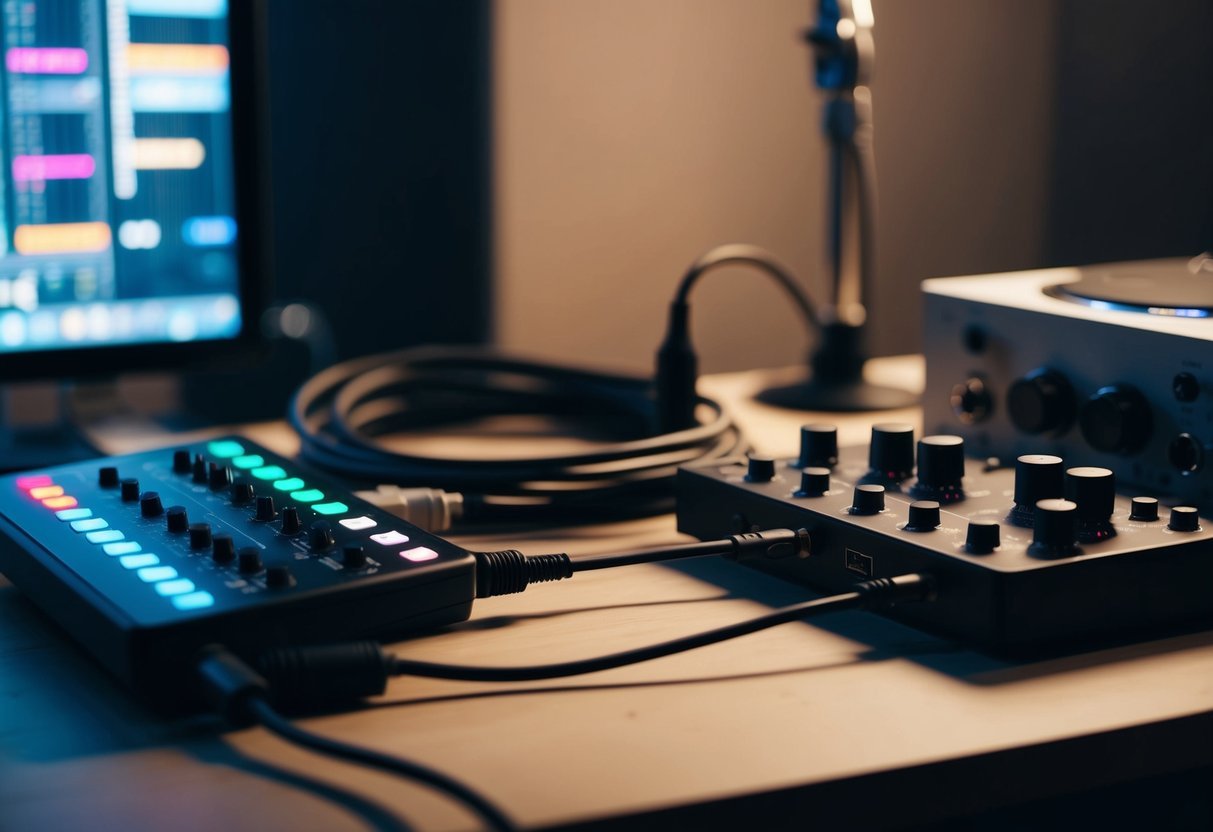
When you’re diving into electronic music, MIDI plays a crucial role.
It’s like the language that electronic musical instruments use to talk to each other.
With MIDI, you can connect keyboards, drum machines, and computers for seamless interaction.
In the world of electronic music, MIDI functionality offers precision.
Sync multiple instruments to one MIDI clock for tight and accurate beats.
This synchronization is a game-changer for producers and live performers.
You can use MIDI instruments to control sound sources digitally.
Think of it as sending instructions—like volume changes or pitch adjustments—to your synthesizer or DAW.
It doesn’t create sounds itself but tells other devices how to do it.
Imagine using your MIDI setup during a live gig.
You can trigger samples and synchronize devices with ease.
Programs like Ableton Live excel in this space, giving you flexibility in your performances.
For those looking to expand their setup, MIDI controllers come in handy.
They offer you control over various parameters without generating sounds on their own.
This allows for creative expression in crafting your music.
The Future of MIDI Controllers

You’re about to see some amazing changes in the world of MIDI controllers.
With MIDI 2.0 around, expect improved communication between your gear.
This means more detailed expression and smarter interactions between instruments and software.
MPE (Multidimensional Polyphonic Expression) is also on the rise.
It lets you control individual notes with unique expressions, like pressure or position.
This flexibility opens up fresh creative avenues for your compositions.
More controllers are integrating CV/Gate Outputs.
This allows you to seamlessly connect and control modular synths alongside your digital setup.
It’s a great way to blend classic analog sounds with modern digital workflows.
Many new controllers now come with USB-C connections and USB Host functionality.
This means faster data transfer and the ability to connect directly to other USB devices without needing a computer.
It’s a simple way to streamline your setup.
DAW integration is getting deeper and more intuitive.
You’ll find tools for triggering loops, adjusting mixer settings, and arranging tracks all from your MIDI controller.
This makes your workflow more efficient and hands-on.
Keep an eye on the evolution of hybrid controllers.
These devices combine traditional keys with touch-sensitive surfaces and pads.
They provide more versatility in how you interact with your music.
New features focus on making your creative process smoother.
So, whether you’re on stage or in the studio, these advancements empower you to make the most of your musical ideas.
Frequently Asked Questions
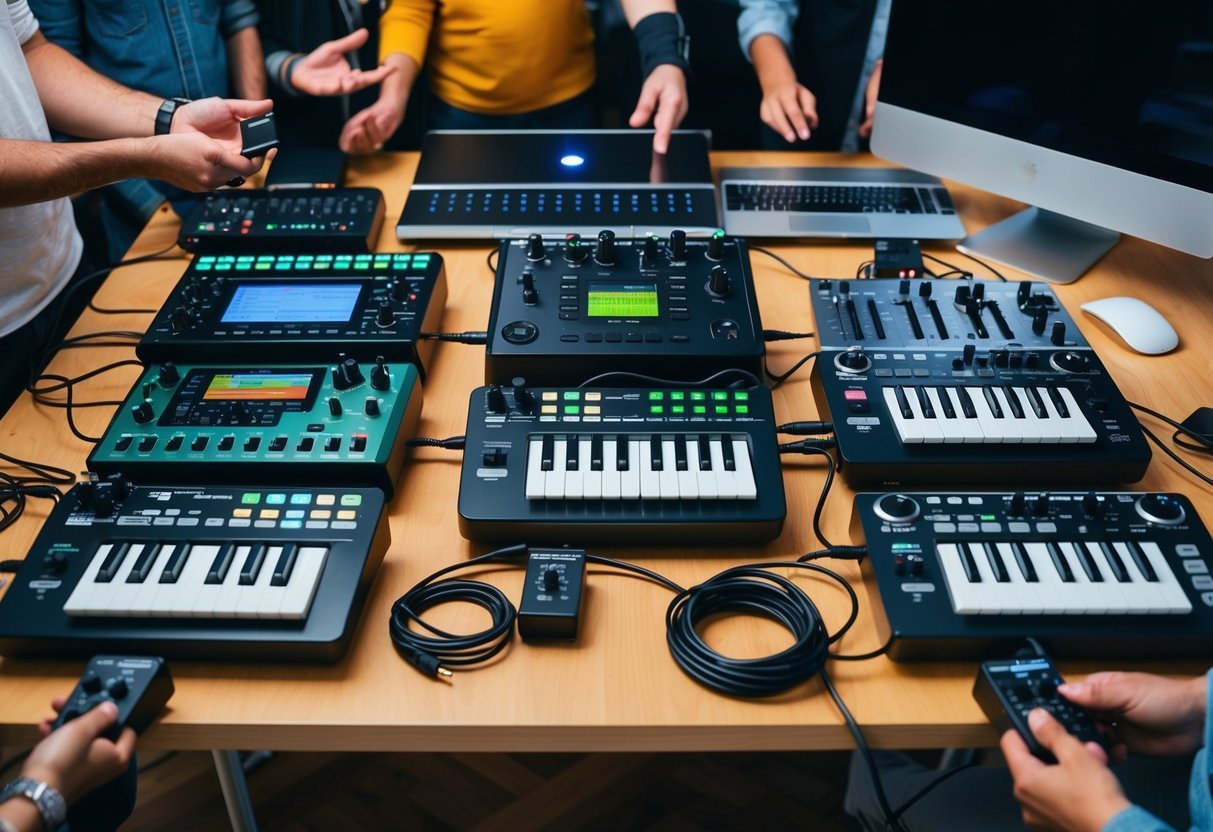
When it comes to MIDI controllers, you want to make sure you pick something that suits your needs and gels well with other tools.
Different controllers come with unique features, and understanding these can help streamline your music production process.
What should I look for when choosing a MIDI controller?
Your choice should depend on features like size, number of keys, and compatibility with your setup.
Portability might also be crucial if you plan to travel.
Consider the kind of controls you need—pads, faders, or knobs—based on what you plan to use it for.
How do MIDI pad controllers differ from regular MIDI keyboards?
MIDI pad controllers focus on triggering samples and beats, often featuring drum pads rather than keys.
They’re handy for electronic music genres where beats are key.
Regular MIDI keyboards usually have keys that make them more suitable for playing melodies and harmonies.
Can you recommend a good software for MIDI controllers?
Many producers opt for Ableton Live or FL Studio because they offer robust integration with MIDI controllers.
Both come with features tailored for live performances and studio use, making them flexible options for various production needs.
What are the essential features of a 61-key MIDI controller?
A 61-key MIDI controller balances compactness with a wide enough range for playing more complex passages.
Essential features often include velocity sensitivity, customizable controls, and easy integration with digital audio workstations (DAWs) or other software.
How do MIDI controllers integrate with music production apps?
Most MIDI controllers connect easily via USB or Bluetooth, allowing you to map controls to specific functions in your DAW.
Some come with auto-mapping features to simplify setup, making integration with apps like Logic Pro and Ableton Live straightforward.
What’s the real difference between a MIDI controller and a MIDI keyboard?
Both devices send MIDI signals.
However, a MIDI keyboard is a type of MIDI controller that’s specifically designed for playing keys, much like a piano.
Other MIDI controllers may include grids, touchpads, or other forms for manipulating sound beyond just playing notes.

